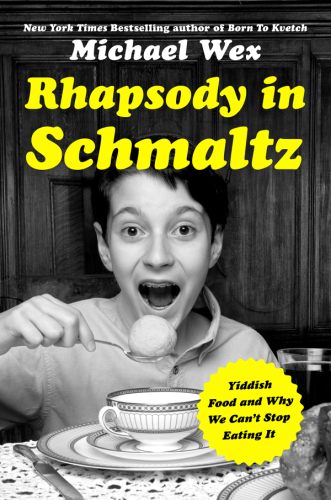
Rhapsody in Schmaltz
Yiddish Food and Why We Can't Stop Eating It
کتاب های مرتبط
- اطلاعات
- نقد و بررسی
- دیدگاه کاربران
نقد و بررسی

February 1, 2016
An enticing tour of Judaism's culinary past. Wex (How to Be a Mentsh (and Not a Shmuck), 2009, etc.) brings lighthearted humor and his considerable expertise on Jewish culture to a wide-ranging look at Jewish food, from biblical dietary restrictions to New York bagels. The Bible forbade Israelites to mix meat and dairy products, eat leavened bread on Passover, and cook on the Sabbath. The last injunction led to the invention of a stew called cholent, which Jews prepared on Friday afternoon and left heating overnight. The meat came from a list of permitted animals: only "ruminants with cloven hoofs." And those must be killed while still conscious, and bled thoroughly, in the koshering process. Permitted fish must have scales and fins; insects, with the exceptions of locusts, grasshoppers, and crickets, were not allowed. Nobody, Wex writes, "ancient or modern, Jewish or gentile, has the vaguest idea of why the forbidden species are forbidden." Some ingredients became pervasive in dishes from many areas, especially garlic, onions, and the delectable schmaltz: rendered fat from chickens or, preferably, geese. Although Wex gives few actual recipes, he does provide one for schmaltz, "the champagne of animal fat." The author explains the popularity of kishka, or stuffed beef intestine tsimmes, a fruit and vegetable stew; the braided challah; chicken soup, which "has served as a specific for what ails the Jews for close to two millennia"; and the latkes (potato pancakes), blintzes (crepes often stuffed with cheese), and bagels that have transcended Jewish cooking and made their ways into mainstream culture. Wex takes on the thorny question of where bagels originated and what constitutes the authentic variety. The bagel, he writes, "has managed the near unimaginable feat of actually becoming American" despite having "half the shelf life of a fruit fly." But topping one with cream cheese and lox began only in the 1930s. Informative, merrily entertaining culinary and cultural history.
COPYRIGHT(2016) Kirkus Reviews, ALL RIGHTS RESERVED.

Starred review from April 1, 2016
Wex (Born To Kvetch) has written a delightful and informative history of Jewish ("Yiddish") food from biblical times to the present, describing its evolution and popularization through media culture and the process of Americanization. This ambitious historical, sociological, and religious analysis describes the importance of the food as it relates to the history of the Jewish people. The author succeeds at many levels. Rules of kashrut (the laws of kosher dietary rules) are detailed, and Yiddish terms are elaborated and defined. Dishes such as challah bread, gefilte fish, tzimmes, cholent, kreplach, and matzah balls are explained and analyzed in both their cultural context as well as their linguistic origins. For example, we learn there is no "schmaltz" in schmaltz herring when the elements that comprise a genuine schmaltz herring are revealed. VERDICT This work will have broad appeal to general audiences. The endnotes and impressive bibliography will prove useful to readers and scholars interested in Jewish food and culture.--Herbert E. Shapiro, Lifelong Learning Soc., Florida Atlantic Univ., Boca Raton
Copyright 2016 Library Journal, LLC Used with permission.

Starred review from April 1, 2016
In his latest book, Wex sets before us a table full of favorite Ashkenazic Jewish foods, explaining their origins and importance to the social life and vernacular of European Jews and their descendants. Schmaltz, the Yiddish word for chicken fat, is a defining ingredient in many of the heritage foods that he lays out like a skilled anthropologist. Without being schmaltzy (sentimental), Wex conveys his knowledge of Yiddish culture and food laws with a healthy dose of humor. Starting with the shall nots in the Bible, Wex points out that matzo, unleavened bread, is the first of many recipes in the sacred texts. Jewish dishes have always been closely associated with the Sabbath and other holidays, which leads Wex to postulate that the less faith a Jew has left in the Bible, the more Jewish meaning pastrami acquires. Jewish foods, like bagels, kugel, smoked fish, corned beef, and cheesecake, have entered American pop culture without losing their essential Jewish identity. Initially served at delis to satisfy the tastes of immigrants, their popularity quickly expanded. Jewish food is attractive precisely because it reminds us of Old World sensibilities stewed, like cholent, into the American melting pot.(Reprinted with permission of Booklist, copyright 2016, American Library Association.)

























دیدگاه کاربران